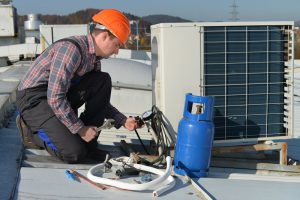Your Guide to Air Conditioner Refrigerant
 Standard air conditioners and heat pumps work thanks to a little chemical known as refrigerant. You may have heard the term in passing while speaking to an HVAC contractor in Albuquerque, NM, or maybe you’ve heard it casually referred to as Freon (which is actually a trademarked brand name). Several air conditioning misconceptions concern what refrigerant is and what it does, so we’ll break it down for you in this post.
Standard air conditioners and heat pumps work thanks to a little chemical known as refrigerant. You may have heard the term in passing while speaking to an HVAC contractor in Albuquerque, NM, or maybe you’ve heard it casually referred to as Freon (which is actually a trademarked brand name). Several air conditioning misconceptions concern what refrigerant is and what it does, so we’ll break it down for you in this post.
It’s Not a Fuel
To understand how refrigerant works, it might help to understand what it isn’t.
It’s not uncommon to believe that refrigerant is a fuel. This would make it seem like you need to get your refrigerant recharged periodically to keep your AC running. Another misconception is that it’s like oil in a car, which keeps it running smoothly and needs to be changed frequently.
Refrigerant should never have to be changed, nor should it ever be depleted!
The Refrigerant Cycle
Refrigerant is a chemical that can easily shift between a liquid and a gas. This phase shift is what helps remove warm air from your home, thus leaving you with cool and conditioned air. That’s right, your AC doesn’t actually generate cold air, it merely creates an absence of warm air.
Here’s a brief step-by-step summary of how refrigerant cools your home:
- It all starts with the compressor, which turns the refrigerant into a hot, high-pressure gas of about 100°F.
- The refrigerant travels to the outdoor condenser coil and releases heat.
- The refrigerant then moves toward the indoor coil and drops in temperature, changing to a liquid at about 20°F.
- The cold refrigerant passes through the evaporator coil and absorbs the warm indoor air.
- The warm refrigerant passes through the compressor, and the cycle repeats.
In summary, the refrigerant absorbs warm air from inside your home and releases it into the outdoors. So now you can understand that the amount of refrigerant is never supposed to change. Your AC should be charged with the proper refrigerant from the very beginning.
Refrigerant Leaks
There are only two situations that you’ll need a refrigerant recharge:
- The HVAC technician who installed your system didn’t charge it properly in the first place.
- One of the coils or the refrigerant lines has sprung a leak.
What we’re most concerned about here are refrigerant leaks. The longer the leak persists, the worse off it will be for your system. Refrigerant leaks typically start as very small pinhole leaks, so you won’t notice that anything’s wrong at first.
The eventual symptoms of refrigerant leaks include increased energy bills, frozen evaporator coils, overheating, and—in a worst-case scenario—compressor failure.
One way to check a refrigerant leak is to see if there are tiny bubbles forming on the coils or refrigerant line–these indicate pinhole leaks. If the leak is larger, you might be able to hear a hissing or whistling noise from the leak. If you suspect you have a leak, turn off the AC and call for repairs.

